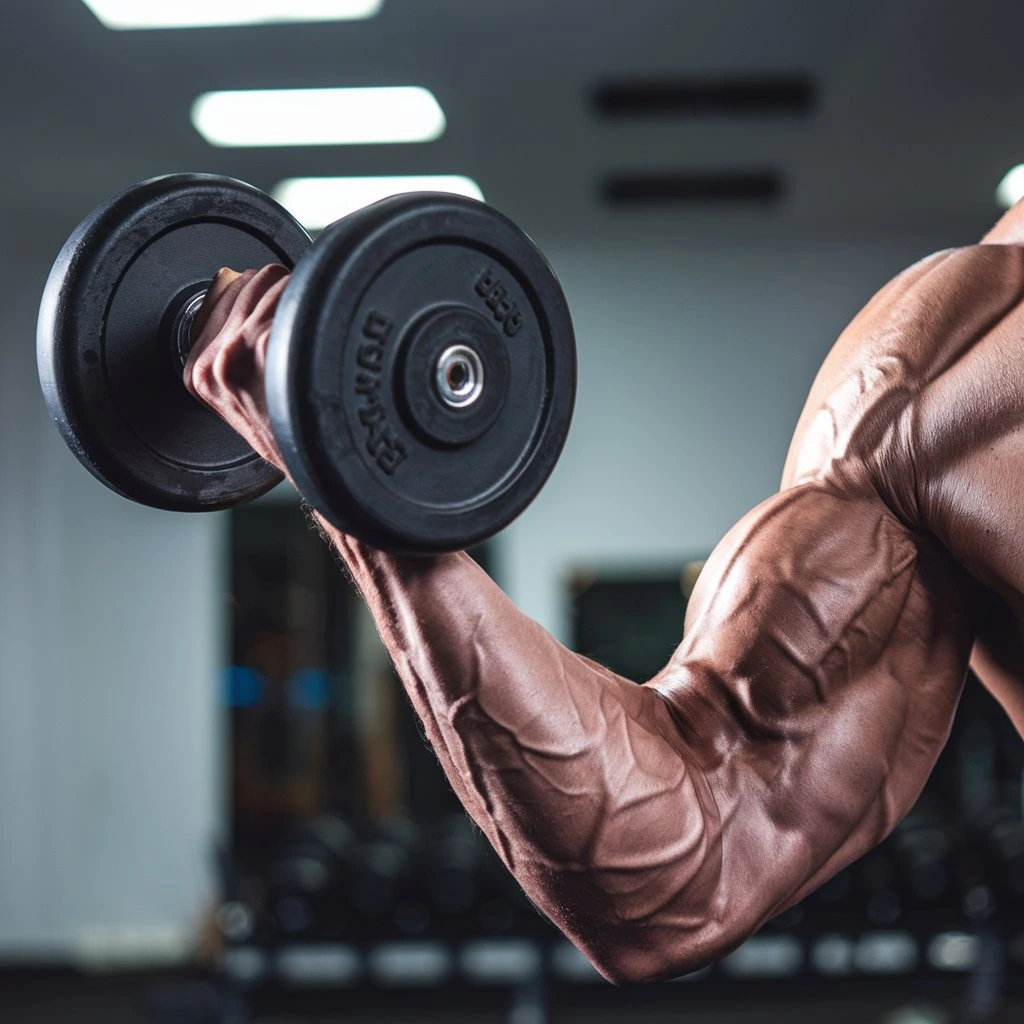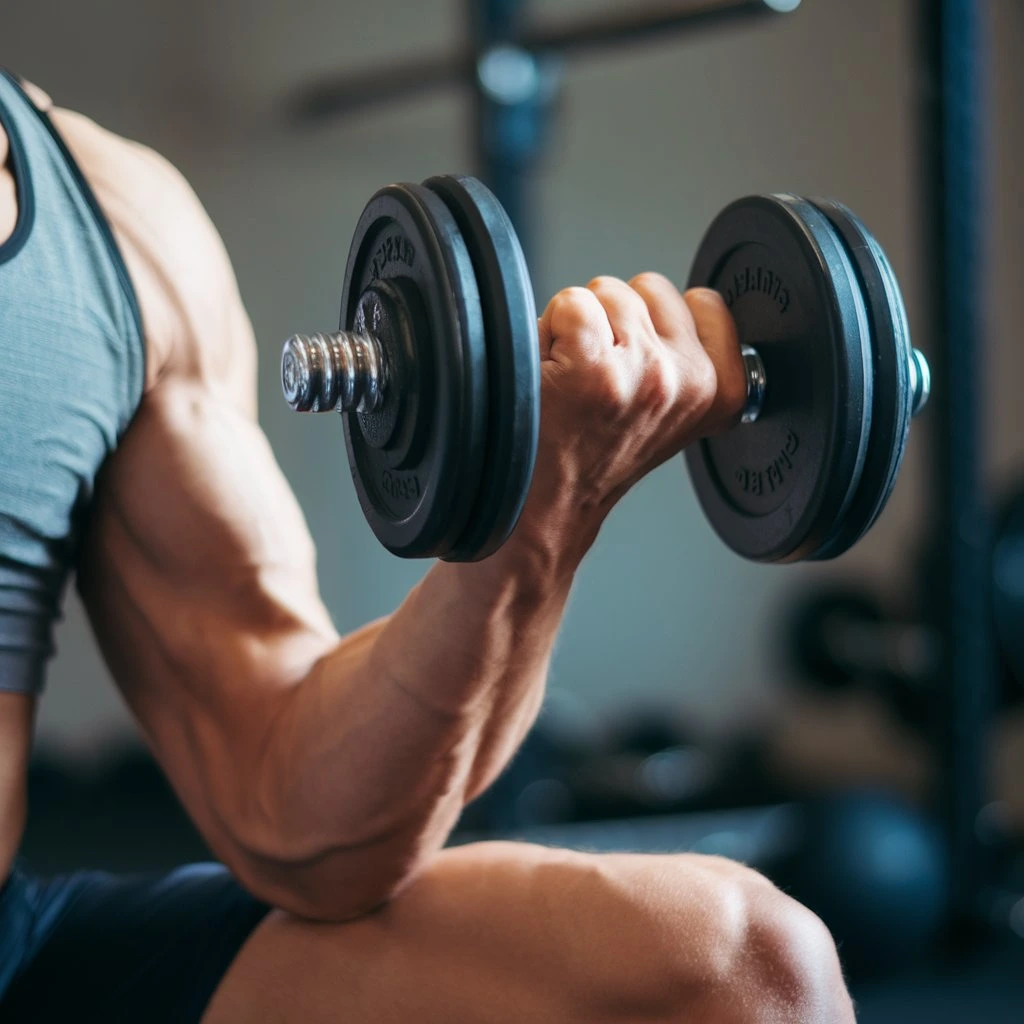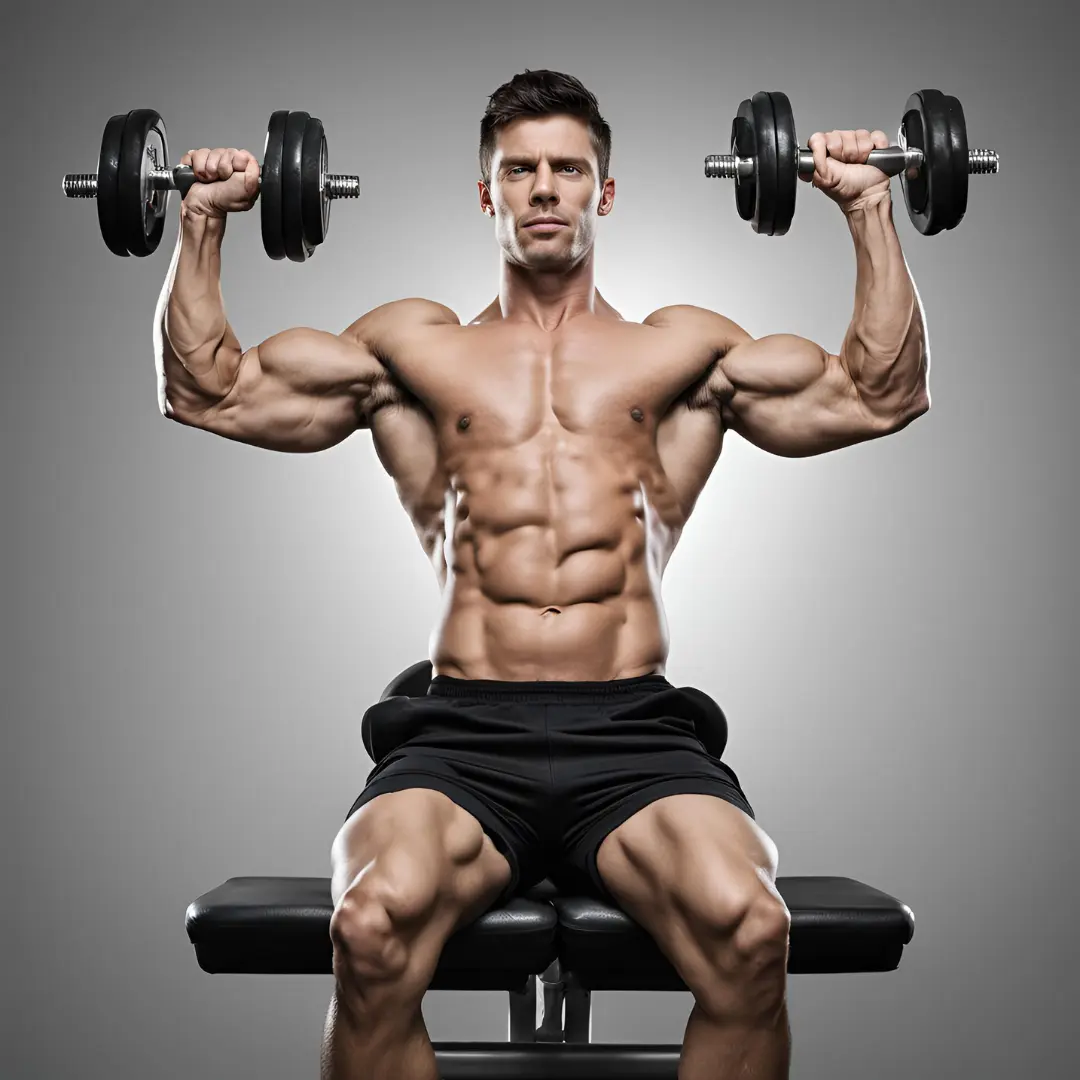Let’s dive into the exciting world of forearm dumbbell workouts. We’ll explore what they are. We’ll look at how they started and changed. We’ll see what’s important about them and how people use them every day.
Basic Concepts
So, what are forearm dumbbell workouts? They’re exercises you do using dumbbells. They strengthen the muscles in your forearms.
Dumbbells are those cool weights you hold in each hand while working out. These workouts help make your forearms stronger and more awesome!
How It Started
Imagine that, way back in history, people used to lift heavy things all the time. This made their forearms super strong without even trying!
Then, people thought, “Hey, why not make specific exercises just for our forearms?” And that’s how forearm workouts began!
Evolution Over Time
As time went on, people got more creative with their workouts. They invented new exercises and techniques. These targeted different parts of the forearm muscles. They also found that using dumbbells was a great way to add resistance. It made their workouts better.
Key Components
Now, let’s talk about the important stuff. Forearm workouts usually involve movements. These include wrist curls, reverse curls, and hammer curls. These exercises target different parts of the forearms. They help make the forearms strong.
Common Uses or Applications Today
You might be wondering, “Why do people do forearm dumbbell workouts today?”
Well, think about all the things you do with your hands every day—like writing, typing, or carrying stuff. Strong forearms make these tasks easier and less tiring.
Also, athletes use forearm workouts. They do this to improve their grip strength. It helps in sports like climbing, tennis, and weightlifting.
Anatomy of the Forearm Muscles
Today, we’re going to learn about the muscles in our forearms. They might seem small. But, they’re very important. They’re used for things like picking up stuff, writing, and playing sports.
Brief Description of Forearm Muscle Groups
So, our forearms have a bunch of muscles working together to help us move our wrists and hands. There are two main muscle groups in our forearms: the flexors and the extensors.
Flexors: These are the muscles on the underside of our forearms. They help us bend our wrists and fingers. Imagine making a fist—that’s your flexor muscles at work!
Extensors: These muscles are on the top of our forearms. They help us straighten our wrists and fingers. Next time you wave hello, think about your extensor muscles doing their thing!
Importance of Targeting Each Muscle Group
Now, why is it important to work on these muscles? Well, each muscle group has its job, and they all work together to help us do stuff with our hands.
Flexors: Strengthening our flexor muscles lets us grip things better. It helps with tasks like holding a pencil or opening a jar without getting tired too quickly.
Extensors: Strong extensor muscles help keep our wrists and fingers steady. This is super helpful when we need to do things like type on a keyboard or catch a ball.
In our forearm workouts, we target both the flexor and extensor muscles. This balances and strengthens our arms. It helps with anything we want to do!

Choosing the Right Dumbbells
Let’s talk about picking the perfect dumbbells for our forearm workouts. It’s like choosing the right wand in a wizarding world—it’s got to be just right!
Explanation of Appropriate Dumbbell Weights
So, when we talk about dumbbell weights, we mean how heavy they are. It’s important to choose a weight that’s not too light or too heavy for us. If it’s too light, it won’t challenge our muscles enough. But if it’s too heavy, we might strain ourselves and get hurt.
Here’s a tip: When we’re starting, it’s best to choose lighter weights. That way, we can learn the exercises properly without putting too much strain on our muscles. As we get stronger, we can add more weight. This will keep challenging us.
Types of Dumbbells Suitable for Forearm Workouts
Now, let’s talk about the different types of dumbbells we can use for our forearm workouts. There are a few options, but they all work great!
Adjustable Dumbbells: These are like magic—they can change their weight! We can add or remove weight plates to adjust the heaviness of the dumbbells. They’re super versatile and perfect for all skill levels.
Fixed-weight Dumbbells: These dumbbells come in a set weight, so we can’t change how heavy they are. They’re great if we know exactly what weight we want to use and don’t need to adjust it.
Resistance Bands with Handles: Resistance bands with handles are not dumbbells. But they’re another option for forearm workouts. They’re like giant rubber bands with handles on the ends. We can pull on them to create resistance and work our forearm muscles.
Warm Up Exercises
Before we start our dumbbell forearm workouts, we must warm up. Think of it like stretching before a big race—it helps get our bodies ready for action!
Importance of Warming Up Before Workouts
So, why do we need to warm up? Well, warming up helps get our blood flowing and our muscles loosened up. It’s like waking up our muscles and telling them, “Hey, get ready for some action!”
When we warm up before workouts, it can:
Help prevent injuries: Warming up prepares our muscles for exercise. This can reduce the risk of strains and sprains.
Improve performance: Warmed muscles work better. So, we can do our exercises well.
Increase flexibility: Warming up increases flexibility. It makes our muscles more flexible. This helps us do exercises with good form.
Recommended Forearm Warm Up Exercises with Dumbbells
Now we know why warming up is important. Let’s look at some cool forearm warm-up exercises. We can do them with dumbbells!
Wrist Rotations: Hold a light dumbbell in each hand and let your arms hang by your sides. Slowly move your wrists in circles, starting clockwise and ending counterclockwise. This helps loosen up the joints in our wrists and gets them ready for action!
Wrist Flexion and Extension: Sit on a chair with your feet flat on the ground. Grip a dumbbell in each hand, palms facing downward. Slowly bend your wrists upward, bringing the dumbbells towards you. Then, lower them. This stretches the muscles on the underside of our forearms.
Wrist Pronation and Supination: Hold a dumbbell in each hand with your palms facing up. Keep your arms at your sides. Rotate your wrists so your palms turn inward (pronation) and then outward (supination). This exercise helps warm up the muscles on the top and bottom of our forearms.

Forearm Dumbbell Exercises
It’s time to flex those forearm muscles with some awesome dumbbell exercises. We’ve got three cool exercises to try out, so let’s dive in!
Wrist Curls
- How-to Instructions:
- Sit on a chair with your feet flat on the ground and hold a dumbbell in each hand.
- Rest your forearms on your thighs, palms facing up, and let your wrists hang off the edge.
- Slowly curl your wrists upward, bringing the dumbbells towards you.
- Hold for a bit, then gradually lower the dumbbells back down.
- Repeat for a set number of reps.
- Variations and Modifications:
- If you’re new to wrist curls, start with lighter weights to avoid straining your muscles.
- You can also perform wrist curls using a single dumbbell if you prefer.
Reverse Wrist Curls
- Step-by-Step Guide:
- Sit on a chair with your feet flat on the ground and hold a dumbbell in each hand.
- Rest your forearms on your thighs, palms facing down, and let your wrists hang off the edge.
- Slowly curl your wrists upward, bringing the dumbbells towards you.
- Hold for a second, then gradually lower the dumbbells back down.
- Repeat for a set number of reps.
- Common Mistakes to Avoid:
- Avoid using too much weight, as it can strain your wrists and lead to injury.
- Keep your wrists straight throughout the exercise to ensure proper form and effectiveness.
Hammer Curls
- Proper Form and Technique:
- Stand up straight and hold a dumbbell in both hands, with the palms facing your body.
- Maintain a motionless upper arm while keeping your elbows close to your sides.
- Curl the dumbbells upward towards your shoulders, keeping your palms facing inward.
- Hold for a bit at the top before carefully lowering the dumbbells back down.
- Repeat for a set number of reps.
- Benefits of Hammer Curls for Forearms:
- Hammer curls target the muscles in the forearms, particularly the brachioradialis.
- They help improve grip strength and forearm endurance, making everyday tasks easier.
Forearm Strengthening Routines
We’ve learned some cool forearm exercises. Now, it’s time to put them into great workouts. Whether you’re a beginner or more advanced, there’s a routine for you!
Sample Beginner Forearm Workout Routine
If you’re just starting, it’s important to take it slow and steady. Here’s a simple routine to get you started:
- Wrist Curls: 3 sets of 10 reps
- Try to start with light weights and practice the appropriate form.
- Reverse Wrist Curls: 3 sets of 10 reps
- Keep your wrists straight and avoid using too much weight.
- Hammer Curls: 3 sets of 10 reps
- Stand tall and curl the dumbbells towards your shoulders with palms facing inward.
Intermediate and Advanced Forearm Workout Routines
First, master the beginner’s routine. Then you can challenge yourself with these intermediate and advanced ones:
Intermediate Routine:
- Wrist Curls: 4 sets of 12 reps
- Reverse Wrist Curls: 4 sets of 12 reps
- Hammer Curls: 4 sets of 12 reps
- Wrist Pronation and Supination: 3 sets of 10 reps each
Advanced Routine:
- Wrist Curls: 4 sets of 15 reps
- Reverse Wrist Curls: 4 sets of 15 reps
- Hammer Curls: 4 sets of 15 reps
- Wrist Pronation and Supination: 3 sets of 12 reps each
- Forearm Plank: Hold for 30–60 seconds, 3 sets
Tips for Progression and Increasing Intensity
As you get stronger, it’s important to challenge yourself and keep progressing. Here are some tips to help you increase the intensity of your workouts:
- Gently raise the weight of your dumbbells as you gain strength.
- Add an extra set or two to your workouts to increase volume.
- Try slowing down the tempo of your reps to make the exercises more challenging.
- Use advanced forearm exercises. For example, use an incline bench for wrist curls. Also, add bands to reverse wrist curls.
- Don’t forget to listen to your body. Give yourself plenty of rest between workouts. This permits your muscles to heal and gain strength.

Common Mistakes and How to Avoid Them
As we work on our forearm exercises, it’s important to watch out for some common mistakes. Let’s learn how to avoid them so we can keep our workouts safe and effective!
Overtraining
Sometimes we might get a little too excited and want to do too much, too soon. Overtraining can lead to tired muscles, injuries, and even burnout. Here’s how to avoid it:
Listen to Your Body: Be aware of how your muscles feel. If you’re feeling tired or sore, it’s okay to take a break.
Stick to a Schedule: Plan your workouts ahead of time. Give your muscles plenty of time to rest and recover between sessions.
Start Slow: Use lighter weights at first. Gradually raise your intensity as you acquire strength.
Incorrect Form and Technique
Using the wrong form or technique during exercises can cause injuries. It also stops us from fully benefiting from our workouts. Here’s how to make sure we’re doing it right:
Watch Yourself: Use a mirror or ask a friend to check your form while you exercise.
Start with Light Weights: They let us focus on form without straining muscles.
Ask for Help: Ask for help if you’re not sure how to do an exercise right. Don’t be afraid to ask a coach or fitness instructor for guidance.
Ignoring Rest and Recovery
Rest and recovery are equally essential as exercise itself. Our muscles need time to repair and grow stronger between workouts. Here’s how to make sure we’re giving our bodies the rest they need:
Take Breaks: Schedule rest days into your workout routine. This gives your muscles time to heal.
Get Plenty of Sleep: Aim for 8–10 hours of sleep each night to help your muscles repair and grow.
Stay hydrated: Drinking enough water helps to flush away pollutants. It also keeps our muscles hydrated and healthy.
Incorporating Forearm Workouts into Your Fitness Routine
Now we know some great forearm exercises. Let’s talk about how to add them to our fitness routine. We want to do this in a smart and balanced way!
Frequency of Forearm Workouts
How often should we do forearm workouts? Well, it depends on our goals and fitness level. Here are some options to assist you figure it out:
Start Slow: If you’re new to forearm workouts, try doing them 2-3 times a week to give your muscles time to recover.
Gradually Increase: As you get stronger, you can increase the frequency to 4-5 times a week if you want.
Listen to Your Body: If your muscles are very tired or sore, it’s okay to take a break and give them extra rest.
Combining Forearm Exercises with Other Muscle Groups
Forearm exercises are great alone. But, they’re even more powerful when we combine them with exercises for other muscles. Here’s how to do it:
Full-Body Workouts: Try adding forearm exercises to your full-body workout routine. This way, you’ll work multiple muscle groups at once and get a great overall workout.
Upper Body Workouts: Forearm exercises pair well with arm, shoulder, and chest exercises. Try bicep curls or shoulder presses first. Then, do wrist curls or reverse wrist curls.
Core Workouts: Don’t forget about your core! Forearm planks and other core exercises can help strengthen your abs and back. They also work your forearms.
Importance of Balanced Training
Balanced training means working all the muscles in our bodies, not just our favorites! Here’s why it’s important:
Prevents Imbalances: Focusing too much on one muscle group causes imbalances. They can lead to injuries and pain.
Improved Performance: When all our muscles are strong and balanced, we do better in our workouts and daily activities.
Keeps Things Interesting: Varying our workouts keeps them fun. It stops boredom. Trying new exercises keeps things interesting.
Recovery and Stretching
Hey, buddies! After a good workout, it’s super important to give our bodies some love and help them recover. Let’s talk about why stretching and recovery are crucial. Also, let’s talk about some cool stretches we can do for our forearms!
Importance of Post-Workout Stretching
Stretching after a workout is like giving our muscles a big hug! It helps them relax, reduces soreness, and keeps them flexible. Here’s why it’s so important:
Reduces Muscle Tension: Stretching helps loosen tight muscles. It reduces tension and relaxes us.
Improves Flexibility: Stretching helps us become more flexible. This is important for preventing injuries and doing better in workouts and activities.
Promotes Recovery: Stretching promotes recovery. It increases blood flow to our muscles. This flow helps deliver oxygen and nutrients to them, helping them recover faster.
Recommended Stretches for Forearms
Now, let’s try out some awesome stretches for our forearms! Here are a few ideas to get us going:
Wrist Flexor Stretch: Hold one arm out in front of you with the palm facing up. Use the other hand to gently pull the fingers of the outstretched hand towards you. Do this until you feel a stretch in the forearm. Hold for 15–30 seconds and then switch sides.
Wrist Extensor Stretch: Hold one arm out in front of you with the palm facing down. Use the other hand to press the fingers of the outstretched hand towards you gently. Do this until you feel a stretch in the top of the forearm. Hold for 15–30 seconds and then switch sides.
Forearm Pronation and Supination Stretch: Hold one arm out in front of you with the palm facing up. Use the other hand to rotate the palm of the outstretched hand towards the floor. Do this gently. Stop when you feel a stretch in the forearm. Hold for 15–30 seconds and then switch sides.
Tips for Effective Recovery
Following an exercise, our bodies require time to rest and heal. Here are some tips to help us recover effectively:
Stay Hydrated: Drink plenty of water to help flush out toxins and keep our muscles hydrated.
Eat Healthy Foods: They fuel our bodies with nutrients. This helps restore energy and fix muscles.
Get Plenty of Sleep: Aim for 8–10 hours of sleep each night to help our bodies recover and grow stronger.
Take Rest Days: Give our bodies a break by scheduling rest days into our workout routine. It’s critical to listen to our bodies and give them the rest they require.
Conclusion
Workouts with dumbbells strengthen our muscles. They are a great way to improve our fitness. We can add exercises like wrist curls, reverse wrist curls, and hammer curls to our routine. They will build stronger and tougher forearms. You should choose the right dumbbells.
Also, warm up before workouts. And avoid common mistakes. These include overtraining and bad form. Stretching and rest after workouts are also crucial. They keep our muscles healthy and prevent injuries.
Let’s add forearm dumbbell workouts to our fitness routine. We will gain the amazing benefits of forearm strength in our daily lives!

